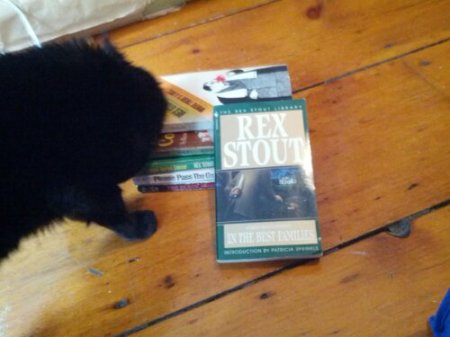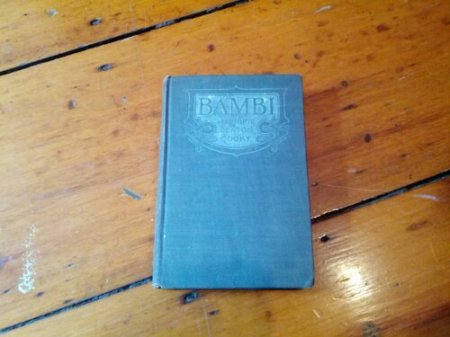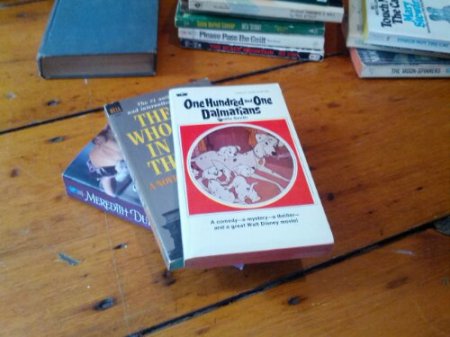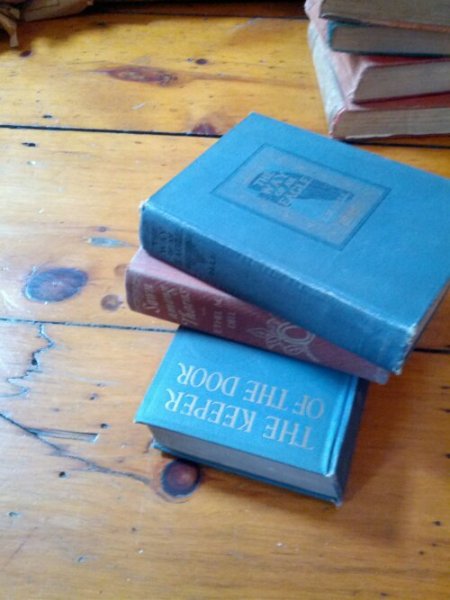new posts in all blogs
Viewing: Blog Posts Tagged with: maryrobertsrinehart, Most Recent at Top [Help]
Results 1 - 13 of 13
How to use this Page
You are viewing the most recent posts tagged with the words: maryrobertsrinehart in the JacketFlap blog reader. What is a tag? Think of a tag as a keyword or category label. Tags can both help you find posts on JacketFlap.com as well as provide an easy way for you to "remember" and classify posts for later recall. Try adding a tag yourself by clicking "Add a tag" below a post's header. Scroll down through the list of Recent Posts in the left column and click on a post title that sounds interesting. You can view all posts from a specific blog by clicking the Blog name in the right column, or you can click a 'More Posts from this Blog' link in any individual post.
This is the weekend of my favorite book sale. It’s held by a small library upstate, very few books are over a dollar, and if you buy a $10 tote bag, you can take home as many books as will fit in it. And that, of course, is what I did.

It's hard to tell in the picture, but this is a really big tote bag.
I usually limit myself to as many books as I can carry in my hands, so when my arms started to hurt, I went to check out. But once I’d gotten by books into my bag, the woman at the counter said, “you know, there are more books in the other building.” That was my downfall.
Anyway, here are the things I got, in reverse order as I unpack.

I didn’t by all the Nero Wolfe books–just the cuter, older paperbacks and In the Best Families because it’s In the Best Families. Apparently my cat likes Nero Wolfe too.

Not the Felix Salten one with the deer, but the Marjorie Benton Cooke one with the people. The woman who helped me check out said she heard it was pretty racy, which seems unlikely, but I told her I would be pleased if that turned out to be the case.

I keep meaning to try Mary Stewart. And at this point I had well over $10 worth of books, so these were basically free.

Some miscellaneous paperbacks–One Hundred and One Dalmatians because my copy is missing pages, The Spy Who Came in From the Cold because I can’t find my mom’s copy, and a romance by Meredith Duran for no reason at all.

This is the Mary Roberts Rinehart portion of the haul. All of these books are more battered than all of the other books, but who cares? I own a copy of K
now.

This is the Ethel M. Dell portion of the haul. I…own a copy of The Way of an Eagle now. So, uh, that’s a thing.

The last few miscellaneous things: Rose in Bloom, my favorite Alcott bok I’ve never owned; Trustee from the Toolroom, which I buy whenever I find it so I can give it as a gift; and Brat Farrar, which I own a couple of times over, because this copy is super cute. I assume the girl in the sheet on the cover is Eleanor, but I don’t understand why.
Tagged:
ethelmdell,
louisamayalcott,
maryrobertsrinehart,
rexstout,
stuff 

Here’s an odd little Mary Roberts Rinehart mystery for you: The Confession. There are a lot of familiar elements here — a middle-aged spinster who has raised a niece and nephew, her alternately loyal and mutinous servant, a house rented for the summer — but it’s not The Circular Staircase and it’s not The Bat. Nor is it as much of a mess as either of those, probably because it’s a lot shorter. The Confession only has about five chapters, at least one of which is primarily composed of Miss Agnes Blakiston’s ramblings about fear. Which is cool, actually. Both the brevity and the rambling, I mean. The lack of length means Rinehart can’t do the overwhelming, 31 flavors of plot thing she likes so much, and the rambling , combined with Rinehart’s head over heels adoration of foreshadowing makes things feel — well, not scary, I guess, but very tense. Kind of like The After House. And, as with The After House, the psychological horror thing mostly works, at least for a while.
I could explain how Agnes Blakiston comes to be in the house for the summer, and why she develops an obsession with the telephone, and I could talk about the suspicious behavior of the owner of the house, and the strangely protective attitude of the telephone operator, and how the solution to the mystery is a little bit silly, as with most of Rinehart’s books, but those things are kind of beside the point, except maybe for the telephone thing. This is the rare Rinehart mystery that makes you think about things like hallucinations and unreliable narrators, and it’s kind of a lot of fun.
Tagged:
1910s,
maryrobertsrinehart,
mystery 

These days I mostly come home from work and sort of collapse. Which doesn’t mean I haven’t been reading — just that I haven’t taken the time to write down anything about the books. I’m trying to knock out my backlog this week, though. If you don’t see a post from me every day from now until Friday, that means I’ve failed. First up is Mary Roberts Rinehart’s Long Live the King!
Even knowing all the other things that Mary Roberts Rinehart can do — the funny short stories, the romantic ones, the adventurish novels, the suspenseful ones, the “had-I-but-known” mysteries, the novels that deal with social issues and modern society, the screwball comedies, etc. — I honestly never thought I’d see her try Ruritanian romance. But Long Live the King! exists, and is set in a vaguely Germanic country called Livonia, where our nine year-old main character, Ferdinand William Otto, is the Crown Prince. His grandfather is a) the King, and b) dying, and the country is probably on the verge of revolution, notwithstanding the fact that everyone kind of loves Otto. The King and the Chancellor suspect that the revolution is going to happen when the King dies, so they’re rushing to cement an alliance with their neighbor/traditional enemy Karnia by letting him marry Otto’s cousin, Princess Hedwig. Which would work, probably, if Hedwig wasn’t already in love with the adorable Captain Nikky Larisch, and if he didn’t tragically worship her in return. As it is, things get a bit complicated.
Seeing as this is Mary Roberts Rinehart and not, say, George Barr McCutcheon, this isn’t exactly a traditional Ruritanian romance. But the more I think about it, the more I feel that the difference lies less in the fact that Livonia feels more like a place I’ve visited with G. K. Chesterton than Anthony Hope than in the composition of the cast of characters. I think Ruritanian romances mostly adhere pretty closely to the Zenda model in that there’s a protagonist from an English-speaking country, a princess, a villain who wants to rule or annex the kingdom in question, and a grizzled old warrior who acts as an advisor. And then, occasionally, there are the revolution-hungry masses, although, again, that’s more of a Chesterton thing than a Hope one. And Rinehart’s got the princess and the villain and the advisor and the masses, but not only is Nikky very much a Livonian and a part of the Livonian system, he doesn’t exactly fill the traditional hero role. And with this four, I’ve introduced only about half of the major characters.
The Royal family of Livonia is properly a family, if a dysfunctional one. Otto’s parents were assassinated when he was a baby, but there’s still his grandfather, his aunt Annunciata, and her two daughters, Hedwig and Hilda. And they don’t always get along, in both dealing-with-royal-mandates ways and regular squbbling family ways. And then there’s old Adelbert at the Opera, struggling with his patriotism. And American Bobby Thorpe and his parents
I blame Eleanor for the amount of Mary Roberts Rinehart I’ve been reading lately. Every time I move on to something else, she tells me which Rinehart she’s reading and I get jealous.
Anyway, I read Love Stories last week. I was pretty sure I hadn’t read it before, but the first story seemed awfully familiar. It turns out I’d already read it in a magazine. But it holds up well. I mean, it’s Rinehart. Of course it does.
This book is kind of a precursor to the hospital romance comics from the 1970s that I read at my grandmother’s apartment when I was younger. All but the last two stories are set in hospitals, and all but the last one are romances. Lots of doctors and nurses. Lots of incidents recycled from or for K.
And mostly it’s fun. There were a couple of stories I didn’t like: “In the Pavilion” is an unconvincing nurse/patient romance. And ”Are We Downhearted? No!” made me increasingly upset as the heroine got less interesting and less independent in order to become “worthy” of the hero, who was kind of an ass. But I liked the rest, some more than others. “Twenty-Two” makes an excellent start to the book, because it’s, like, 90% of the other stories in a nutshell. If you don’t like “Twenty-Two,” you might as well put the book down. Which is not to say that it’s the best story in the book, although it’s definitely in the running. I think “Jane” might have been the most successful story, but it was also the least ambitious. It’s funny and sweet and not much else, but it doesn’t need to be.
“The Game” was sort of the most interesting to me. It has nothing to do with hospitals whatsoever, and not much to do with romance. The Scottish engineer has a vaguely tragic love story in his past, but the story’s about his relationship with the red-headed orphan he sort of adopts, and it’s painfully adorable.
I’m not feeling super enthusiastic about Love Stories right now, but I enjoyed it a lot when I was reading it. The stories here are distilled Rinehart, so you get <em>all</em> the feelings, but not much that will stick with you after they’re gone. Which is maybe what light reading is for.
Tagged:
1910s,
maryrobertsrinehart,
romance,
shortstories,
transatlantic voyages 



![]() 3 Comments on Love Stories, last added: 3/24/2012
3 Comments on Love Stories, last added: 3/24/2012
By: Melody,
on 2/1/2012
Blog:
Redeeming Qualities
(
Login to Add to MyJacketFlap)
JacketFlap tags:
stratemeyer,
johnbuchan,
williamsons,
erskinechilders,
margaretwiddemer,
maryrobertsrinehart,
reviewsatep,
grantallen,
richardhardingdavis,
templebailey,
williamjohnlocke,
herbertgeorgejenkins,
marie belloc lowndes,
emilypost,
ephillipsoppenheim,
franceshodgsonburnett,
georgegibbs,
georgetompkinschesney,
johngalsworthy,
lillianbell,
margaretvandercook,
marionpolkangellotti,
mrs.alexander,
mrsvcjones,
percykeesefitzhugh,
releake,
stellabenson,
williamlequeux,
books,
1900s,
1910s,
1890s,
1870s,
elinorglyn,
bertaruck,
coningsbydawson,
alicebemerson,
arthurgleason,
clairwhayes,
edgarwallace,
list,
Add a tag
There have been a lot of articles and blog posts floating around lately about what to read if you’re into Downton Abbey. One in particular, which talked about Elizabeth von Arnim apropos of one character giving a copy of Elizabeth and Her German Garden to another, made Evangeline at Edwardian Promenade say, “hey, what about Elinor Glyn?” Which, obviously, is the correct response to everything. And then I read it, and thought, “yeah, Elizabeth and her German Garden was popular when it came out in 1898, but would people really be trying to get each other to read a fifteen rear-old(ish) novel by a German author during World War I?” And then we decided that we could probably come up with an excellent list of Edwardian and World War I-era fiction that tied in the Downton Abbey. And so we did.
It’s a pretty casual list, mostly composed of things we came up with off the tops of out heads, a bit of research on Evangeline’s part and a bit of flipping through advertisements on mine, so we’re making no claims to be exhaustive. If you have suggestions for additions to the list, leave a comment.
Tagged:
1870s,
1890s,
1900s,
1910s,
alicebemerson,
arthurgleason,
bertaruck,
clairwhayes,
coningsbydawson,
edgarwallace,
elinorglyn,
emilypost,
ephillipsoppenheim,
erskinechilders,
franceshodgsonburnett,
georgegibbs,
georgetompkinschesney,
grantallen,
herbertgeorgejenkins,
johnbuchan,
johngalsworthy,
lillianbell,
list,
margaretvandercook,
margaretwiddemer,
marie belloc lowndes,
marionpolkangellotti,
maryrobertsrinehart,
mrs.alexander,
mrsvcjones,
The Amazing Interlude is my new favorite World War I romance. I’m not sure I had one before, but whatever. Mary Roberts Rinehart is, as usual, great, and she has the added advantage of having made a trip over to Europe to check out the trenches and stuff, so she knows what she’s talking about. Not that The Amazing Interlude is as gruesome, serious and propagand-filled as Kings, Queens and Pawns, her account of what she saw at the front, but it doesn’t need to be. It’s light fiction with a high moral purpose, and as such it functions perfectly.
Sara Lee Kennedy, the heroine, lives in Pennsylvania with her aunt and her uncle. It’s the early days of the war, and most Americans are only vaguely concerned with it, but the more Sara Lee thinks about it, the more she feels that she needs to go over to Europe and do something to help, except that she’s not a nurse and she doesn’t know how she can be useful. After her uncle dies, Sara Lee’s fiancé, Harvey, wants to get married immediately — her aunt is moving in with a cousin, and Sara Lee needs to live somewhere. Harvey thinks that the war isn’t their concern, and that her interest in it is silly. The members of the Methodist Ladies’ Aid Society, on the other hand, are more like Sara Lee — they all feel a bit guilty that they’re not doing more to help. And that’s how Sara Lee convinces them to allow her a hundred dollars a month to go to Belgium and run a soup kitchen for soldiers at the front.
Harvey tells her she can’t go, but she replies that she was telling him what she was going to do, not asking for his input. It’s pretty awesome.
Once she’s in London, Sara Lee realizes that getting to the front is going to be a lot more complicated than she expected, and that every person in a position to give her an appropriate visa is also obligated to suspect her of being a spy. But she makes friends, first with an Englishman whose son is a soldier, and then with Henri, a Belgian spy. Henri is great. I mean, he’s got all the expected things covered: he’s massively brave, he falls in love with Sara Lee at the drop of a hat (or, more precisely, a donkey), he’s involved in a deeply homoromantic relationship with his chauffeur, etc. But he’s also kind of a nervous wreck. It’s very endearing.
Henri sneaks Sara Lee into France, and then he and his best friend/chauffeur Jean install her in a partially bombed-out house a quarter of a mile behind the Belgian front line. They find her a maid, Marie, and a guard, Rene, and the three of them set up their soup kitchen. Henri and Jean secretly subsidize it, and Henri teaches Sara Lee how to deal with the soldiers’ more minor injuries, and the house becomes very popular and even a little famous, to the point that Sara Lee receives a medal from the King of Belgium. Meanwhile, she keeps writing letters to the Methodist Ladies, who are satisfied with the results of their investment, and to Harvey, who is less happy. His letters a) belittle her efforts, b) try to make her feel guilty about leaving him, and c) show him to be a selfish, small-minded person. And while Sara Lee is being faithful to him and trying to convince herself that she’s still in love with him, he’s going to the Methodist Ladies behind her back to try and get them to cut off her allowance.
And eventually he succeeds, and Sara Lee’s “amazing interlude” is over.
Harvey is really a piece of work. Every time he appeared, he raised another red flag. My personal favorite bit of Harvey-behavior was when, after Sara Lee’s return, some reporters asked him if it was true that she’d been decorated by the King of Belgium, to which he responds that he doesn’t know, doesn’t care, and what did they think she was doing, fighting? Also, Sar
People who have been reading this blog for a while can probably tell what my favorite things are: secret insane wives, ridiculously melodramatic situations written well, fictional famous people, rounded and sympathetic secondary characters, spontaneous human combustion, etc.
At this point, I believe Mary Roberts Rinehart can do pretty much anything. In the past week, I have read works by her including humorous short stories, serious short stories, a mystery novel, a funny novel, and a serious novel, and they were all thoroughly enjoyable.
K was the serious novel. It does not include spontaneous human combustion.
The book gets it’s name from the central character — he goes by K. Le Moyne, and it’s obvious from the first that it’s an assumed name, but he can’t think of any first names he likes that begin with K, so everyone just calls him by the initial — but really it’s about the Street, a lower middle class neighborhood where most of the characters live.
Sidney Page lives in a house on the Street with her invalidish mother, Anna, and Anna’s spinster sister Harriet Kennedy. The book begins when they take in K. as a lodger. Soon after, Harriet moves out and becomes a fashionable dressmaker. Then Sidney decides to become a nurse, and leaves the house in K.’s care while she takes up residence at the hospital.
Other occupants of the street include:
- Joe Drummond. He’s in love with Sidney and doesn’t react well when she decides she’d rather become a trained nurse than marry him. He, um, shoots someone.
- Mrs. McKee, who serves meals to other peoples’ lodgers (including K.) and eventually marries a deaf and dumb book agent.
- Tillie, Mrs. McKee’s waitress. She’s where the secret insane wife comes in: her gentleman friend, Mr. Schwitter, has one. He’s not a bad guy, really, and he’s told Tillie all about the wife. She eventually agrees to fake-marry him, which seems alternately like a good choice and a bad one.
- Christine Lorenz, a friend of Sidney’s who marries a man named Palmer Howe, who turns out to be kind of an ass. The move into the first floor apartment in Sidney’s house, and Christine and K. become close friends, while Palmer takes up with his former mistress and crashes his car.
- Drs. Ed and Max Wilson — Ed is the elder brother, a GP, who has sacrificed a lot to give Max every possible advantage, and Max is the younger brother who isn’t quite worth it. I mean, he’s a brilliant surgeon and all, but he’s the kind of guy who pursues a lot of women without giving any thought to what kind of effect that will have on them. And he’s devastatingly attractive, and there are rules about fraternization between doctors and nurses. He likes Sidney, and she likes him.
- The Rosenfelds, who represent the lower end of the class spectrum. Mrs. Rosenfeld takes in ironing, or something. Johnny is Palmer Howes’ chauffeur, and when Palmer overturns his car, Johnny is the one who ends up in the hospital. Mr. Rosenfeld is a deadbeat, and K. helps the rest of the family send him to the poorhouse, which is apparently a good thing.
- Reginald, a squirrel.
The only significant character who doesn’t live on the Street is Carlotta Harrison, who is many things: half-Spanish, Dr. Max’s lover, a trainee nurse, a person with knowledge of K.’s past, and moderately evil. She doesn’t like Sidney very much.
So, stuff happens. Lots of stuff. The shooting, the car crash, Tillie’s bastard child, the bit where Carlotta Harrison switches the labels on a couple of medicine bottles so that Sidney will give Johnny Rosenfeld the wrong medicine, the slightly anticlimactic r
Circumstances conspired to make me compare The House of a Thousand Candles to The Circular Staircase. First, I started reading them at the same time–the Rinehart on my Kindle, the Nicholson on my phone. Then, when I googled Meredith Nicholson, I came up with an article on Michael Grost’s Guide to Classic Mystery and Detection that explicitly compared the two. So most of the time that I was reading the Nicholson book, I was thinking about Rinehart. And I was expecting Nicholson to compare pretty badly.
The thing I’ve always said about Mary Roberts Rinehart–at least to myself–is that her best quality is her sense of humor. And apparently Rinehart agreed, saying that the problem with her competitors was a lack of humor. Mike Grost offers The House of a Thousand Candles as an example of those humorless competitors, but I think he’s being a little unfair. I can think of much worse offenders. Anna Katherine Green, for one. But because of Grost’s piece, I was expecting House of a Thousand Candles to be pretty bad, so I ended up being pleasantly surprised–and that’s not a bad thing to be.
Our hero is John Glenarm, and in a lot of ways he’s typical of mstery/adventure novels from this era–sort of in the Grenfell Lorry mode, you know? Upper middle class, trained to a profession, brave and honorable and equally at home in a gunfight or a lady’s parlor. Unlike Lorry, though, Jack Glenarm does not appear to think that the world revolves around him. This is, to say the least, a quality I value in narrators. Jack is mostly pretty likeable, actually. And I love his relationship with his dead grandfather–how determined Jack is to carry out his wishes, and how Nicholson shows us how much alike they are without making Jack conscious of it. Too often first-person narration only tells you things that the narrator is aware of, but Nicholson has been cleverer than that.
Jack’s profession is engineering, and this story would not be taking place at all if he had chosen architecture instead. His grandfather, John Marshall Glenarm, is a little bit obsessed with architecture–and by a little, I mean a lot–and wanted Jack to study it too, but Jack decided to travel around the world with his disreputable friend Larry Donovan and burn through the fortune his father left him instead. That takes him about three years.
Then he gets a notification from Arthur Pickering, his grandfather’s lawyer/protege, who Jack has detested since they were at school together: John Marshall Glenarm is dead, and while Jack has inherited his property, there are some conditions attached. The main one is that Jack must go to Annandale, his grandfather’s half-finished estate in Indiana, and stay there for a year. Otherwise the property goes to Marian Devereaux, the niece of the Protestant nun who runs a girls’ school on an adjacent piece of land. One of the other conditions is that Jack can’t marry her. And one more thing: John Marshall Glenarm’s estate is considerable poorer than expected, and Jack suspects Pickering of some kind of wrongdoing. So does Larry, who appears unexpectedly in New York, on the run from the law after, I don’t know, killing somebody in Ireland, I think.
Annandale is pretty weird. Half the rooms aren’t habitable, but there’s a gigantic library full of books on architecture, and it’s lit entirely by candles. Also a dungeon, which John Marshall Glenarm’s servant, Bates, uses to store potatoes.
Bates is also
So, um, bear with me here. This was written and posted entirely from my phone, and I’m having some trouble italicizing things, so I’ve decided…not to. I will fix it later, I promise. And I’ll add more links, too. And that thing that places most of the post behind a cut tag.
I decided after my second Mary Roberts Rinehart book that I was a fan, and The Circular Staircase is, I think, my fifth. It might be the first one I read about, though, because MRR is remembered primarily as the originator of the Had-I-But-Known school of mystery fiction, and The Circular Staircase is the prime example.
Had-I-But-Known mysteries are the ones with first person narrators who are constantly saying things like “I would never have gone if I knew then what I know now,” and “this would prove to be important later” and other irritating things along the same lines–things that are apt to make readers who are caught up in the story…un-catch. Please, someone, give me a better way to phrase that. Anyway, it’s a style I wouldn’t want to encounter in the hands of any author with less of a sense of humor than MRR. She mostly makes it work, but I don’t think many others could.
And this isn’t Rinehart’s best work. The main character, Rachel Innes, is engaging despite her tendency to spout had-I-but-known-ish phrases, but she’s overwhelmed by clutter.
Rachel is a spinster who has had custody of her orphaned niece and nephew since they were children. Halsey and Gertrude are now 20 and 24, respectively, and they’ve talked their aunt into renting a house in the country for the summer. The first night Rachel is there, the is a mysterious tresspasser and something falls down the stairs in the middle of the night. The second, after Halsey and Gertrude have arrived, there is a murder, and Halsey and the friend he’s brought to stay disappear. Halsey returns a few days later, without his friend and without an explanation, but by then half a dozen other crazy things have happened, and all you can do is try to take them all in and hope they make sense eventually.
I couldn’t synopsize this book in less than fifty pages, but here are some things that happen: Rachel finds some cufflinks. The butler dies of fright. Some plates are broken. The housekeeper gets blood poisoning. A child does not know where he lives. The stable burns down. Halsey turns out to be engaged to the murdered man’s sister. Shaving off a moustache turns out to be an astonishingly effective disguise. Also there’s a secret room and a midnight visit to a graveyard, two things that always make me think of A Woman Named Smith.
And, okay, filling a book with mysterious events that have no clear connection to each other is a fairly effective way of writing a mystery. But it also makes the bit at the end where everything is explained go on for far, far too long. Again, it’s okay because it’s Mary Roberts Rinehart, but I’d prefer a book where I didn’t have to make excuses for her.
I don’t have to make excuses for Rachel, though. She’s great. Rinehart’s protagonists always are–sensible and practical and brave and stubborn and mostly able to see the funny side of things. The cool thing about Rachel in particular is her relationship with the detective, Mr. Jamieson. We don’t get to see as much of it as I’d like, but what there is is intriguing. He obviously picks her out from the beginning as the most sensible and trustworthy person around, even though he knows she’s not telling him everything. And Rachel trusts him, too, although in a less obvious way. She avoids telling him things that she believes incriminate Halsey and Gertrude, but she relies on him quite a bit. I think she knows that Jamieson is going to get it right in the end, although as it turns out, he needs a bit of help from her first. My favorite bit is when, after the inquest, she invites
So, it should come as no surprise that I think Mary Roberts Rinehart is awesome. And part of the reason for that is that she’s always at least a little bit surprising. I had no idea what to expect from The Truce of God, her Christmas story, and I’m not altogether sure what I think of it now, but I’m definitely impressed.
First of all, the Truce of God is a pretty cool thing to write about. During the eleventh century, the European nobility were referred to as “those who fight” (as opposed to “those who work” and “those who pray”), because basically they spent most of their time fighting private wars against their neighbors (or their overlords’ neighbors). The church dealt with this in a few different ways. One was the Crusades. Another was the Truce of God. Basically, the Church said, “Hey, no one is allowed to fight on weekends anymore. Or Thursdays. Or Lent, etc.” The Catholic Encyclopedia has a little more detail, if you’re interested (in general, it’s a good basic resource for medieval religious history).
Rinehart’s story is set in an 11th century town ruled by a guy named Charles. Charles is, of course, fighting a private war with a neighbor — one who also happens to be his cousin. Philip comes after Charles in the succession, which is the primary reason Charles hates Philip so much.
Actually, Charles is kind of obsessed. He’s gone so far as to kick his wife out of the castle because she hasn’t provided him with a son. She’s taken refuge with Philip, which makes Charles furious, and left their daughter behind, which sort of seems to make the whole thing worse. The daughter, Clotilde, misses her mother but also sort of hero-worships her father.
Anyway, it’s Christmas, and Charles isn’t allowed to attack Philip’s castle or he’ll be excommunicated, so he spends his excess energy lusting after Joan, a beautiful girl from the town, who is already involved with Guillem, one of Charles’ guards. Both with their relationship and Charles’ estrangement from his wife, there’s something very modern about the romance in The Truce of God. These are definitely 1920s people in medieval clothing, but in a good way. I mean, modern sensibilities make for a better middle ages than lots of stilted and self-consciously medieval language, right? Whatever the reason, it sort of works.
Anyway, all the characters get their problems sorted out, pretty much, although it’s unclear at the end whether Philip is or isn’t kind of an asshole. I sort of wish Rinehart had done a little more with the Truce of God, though. I mean, she does use to to good effect — it sort of serves to make Christmas more Christmassy — but she doesn’t effectively contrast the truce with the regular state of affairs, so it doesn’t seem as significant as it might otherwise.
Also, there are illustrations, which are nice, if self-consciously medieval — you know what I mean: everyone looks like they’ve escaped from a copy of Howard Pyle’s Robin Hood.


 0 Comments on Christmas Stories: The Truce of God as of 1/1/1900
0 Comments on Christmas Stories: The Truce of God as of 1/1/1900
By: Melody,
on 10/6/2009
Blog:
Redeeming Qualities
(
Login to Add to MyJacketFlap)
JacketFlap tags:
books,
bestseller,
1900s,
1910s,
eleanorhallowellabbott,
williamsons,
georgebarrmccutcheon,
genestrattonporter,
eleanorhporter,
jeanwebster,
maryrobertsrinehart,
mauricehewlett,
Add a tag
I’ve spent some time lately looking at lists of bestsellers from the early twentieth century. I probably won’t ever read all of these books, but the list seems like a good source of recommendations. And Project Gutenberg, as it turns out, has the list handily formatted with links to the available etexts. So here’s that, [...]












K!
This is why I avoid used-book stores and sales…I wouldn’t be able to resist overloading! But I am going to scout out a couple of used-book stores one of these days to look for a couple books by my favorite obscure authors. I just won’t let myself buy anything that isn’t on my list. Seriously. I mean it…
I’ve only read two Mary Stewart books so far (Nine Coaches Waiting and The Moonspinners), but I adored both of them and am eager to read more.
What fun! Would love to curl up on a rainy night with
any of those.
What fun! I do envy you having all those Mary Stewart books ahead of you. And Brat Farrar is one of my all-time favourite books. Have you read Josephine Tey’s other books? They’re wonderful too!
I can’t resist a used book sale either.
I don’t recall “Bambi” being particularly racy. It’s also, alas, not as good as “Cinderella Jane”.
I know!
I feel like I get away with it because this is the primary way I buy books — I rarely buy new stuff. If you’re looking for specific stuff, though, used book stores and book sales aren’t really the way to go — the magic of them is that you never find the specific thing you want, but you often find things you would not even have dared to hope for. For specific things, ABE books is probably better.
I’ve started The Moonspinners and I’m really enjoying it. Apparently it was made into a Disney movie with Hayley Mills, too, so I’m going to see if I can track that down.
Yeah, a rainy night — or even a reading vacation — is called for, but it’s going to have to wait until the Stanley Cup playoffs are over, probably.
I’m reading The Moonspinners now, and can easily imagine tearing my way through all her books in the near future. Are the Arthurian ones worthwhile, too, or just the modern ones?
I’m a huge fan of Josephine Tey, with the caveat that her racial/biological determinism makes me super uncomfortable. And Brat Farrar is probably my favorite, followed by The Franchise Affair.
You know, Marjorie Benton Cooke sounded really familiar to me, but I didn’t remember that it was because she wrote Cinderella Jane. I don’t know if I’m looking forward to it more or less now. And yeah, I’m pretty sure she was mistaking it for another book.